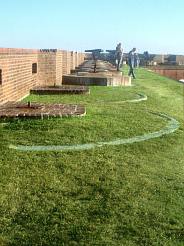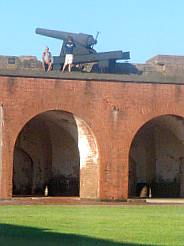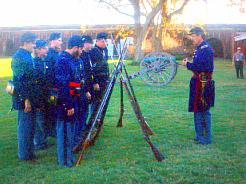Fort Pulaski
A forgotten Civil War Battle
Savannah, GA
November 11th, 2005
A casual look at  a
map might leave one with the impression that Savannah is on the Ocean.
Actually, it's on the Savannah river. The land
between the city and the ocean is mostly swampy with several islands as part of
the delta. The one next to the ocean is Tybee Island. It's now a high
price resort island where the likes of Sandra Bullock have summer homes.
In the middle of the island is a campground. The whole place is accessible
by bicycle. There are beaches on two sides. Across
a
map might leave one with the impression that Savannah is on the Ocean.
Actually, it's on the Savannah river. The land
between the city and the ocean is mostly swampy with several islands as part of
the delta. The one next to the ocean is Tybee Island. It's now a high
price resort island where the likes of Sandra Bullock have summer homes.
In the middle of the island is a campground. The whole place is accessible
by bicycle. There are beaches on two sides. Across the Savannah River is
Cockspur Island where the Fort Pulaski National Monument is located. The fort
itself is not old by American Standards. President Madison authorized it
after the War of 1812 but construction was not completed until 1829. One
of those responsible for the building was a brilliant new Second Lieutenant,
right out of West Point by the name of Robert E. Lee. The fort was named
for Kazimierz Pułaski, a
the Savannah River is
Cockspur Island where the Fort Pulaski National Monument is located. The fort
itself is not old by American Standards. President Madison authorized it
after the War of 1812 but construction was not completed until 1829. One
of those responsible for the building was a brilliant new Second Lieutenant,
right out of West Point by the name of Robert E. Lee. The fort was named
for Kazimierz Pułaski, a  Polish immigrant nobleman who served with
distinction as a Revolutionary War commander, until his death at the battle of
Savannah. The Fort was finally completed in 1847 following 18 years of
construction and over a million dollars in cost. There are an estimated 25
million bricks used in its construction. Upon its completion, it remained unmanned.
In 1860, only 2 caretakers were stationed
Polish immigrant nobleman who served with
distinction as a Revolutionary War commander, until his death at the battle of
Savannah. The Fort was finally completed in 1847 following 18 years of
construction and over a million dollars in cost. There are an estimated 25
million bricks used in its construction. Upon its completion, it remained unmanned.
In 1860, only 2 caretakers were stationed there. In 1860 the Governor of
Georgia, although not having seceded from the Union yet, sent a steamboat down the
river with 110 Georgia regulars and demanded the surrender of the Fort.
The two caretakers capitulated. In February of the following year, when Georgia
did secede the fort was occupied by Confederate troops. There was also a small
garrison of troops stationed on Tybee Island, but the powers to be,
considered their position tenuous at best and ordered the garrison recalled to
the fort. The Confederates were quite familiar with the construction of
the Fort, since it had been built for the most part with local slaves, contracted
from the surrounding land owners. This would later allow Union
there. In 1860 the Governor of
Georgia, although not having seceded from the Union yet, sent a steamboat down the
river with 110 Georgia regulars and demanded the surrender of the Fort.
The two caretakers capitulated. In February of the following year, when Georgia
did secede the fort was occupied by Confederate troops. There was also a small
garrison of troops stationed on Tybee Island, but the powers to be,
considered their position tenuous at best and ordered the garrison recalled to
the fort. The Confederates were quite familiar with the construction of
the Fort, since it had been built for the most part with local slaves, contracted
from the surrounding land owners. This would later allow Union  troops to
slip across from Hilton Head Island and occupy Tybee Island, where they busied
themselves building redoubts for their cannons. Still the Fort's defenders were
unconcerned as the walls of the fort were quite thick and believed its walls
could not be breached by cannon, besides there were no smoothbore cannons that
could shoot that far with any accuracy. On April 10th, 1862, the Union Commander,
out of a courtesy, asked for the surrender of the Fort. The defenders
declined. But the North had been busy in their munitions factories
and fierce new weapons of destruction had been invented. The rifled cannon
was the new powerhouse of artillery. Rifling in the barrel of the cannon
made the shot spin
troops to
slip across from Hilton Head Island and occupy Tybee Island, where they busied
themselves building redoubts for their cannons. Still the Fort's defenders were
unconcerned as the walls of the fort were quite thick and believed its walls
could not be breached by cannon, besides there were no smoothbore cannons that
could shoot that far with any accuracy. On April 10th, 1862, the Union Commander,
out of a courtesy, asked for the surrender of the Fort. The defenders
declined. But the North had been busy in their munitions factories
and fierce new weapons of destruction had been invented. The rifled cannon
was the new powerhouse of artillery. Rifling in the barrel of the cannon
made the shot spin and travel very straight at far greater distances. The
South had no comparable weapon. The bombardment lasted only 30 hours
before the rifled shells had blown a sufficiently large enough hole in the south
wall.
With shells now passing through the wall and landing dangerously close to the
power magazine, the Commanding officer felt he had no choice but to lower the
flag and surrender; thus ending the battle for Fort Pulaski. In addition
to the scenery and history, there were ample docents about, acting as they would
have during the Union occupation of the Fort. This is a nice outing and
there are other parts of the park to see, so leave some time to wander.
and travel very straight at far greater distances. The
South had no comparable weapon. The bombardment lasted only 30 hours
before the rifled shells had blown a sufficiently large enough hole in the south
wall.
With shells now passing through the wall and landing dangerously close to the
power magazine, the Commanding officer felt he had no choice but to lower the
flag and surrender; thus ending the battle for Fort Pulaski. In addition
to the scenery and history, there were ample docents about, acting as they would
have during the Union occupation of the Fort. This is a nice outing and
there are other parts of the park to see, so leave some time to wander.
*** THE END ***
